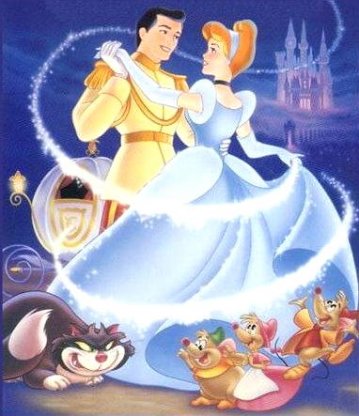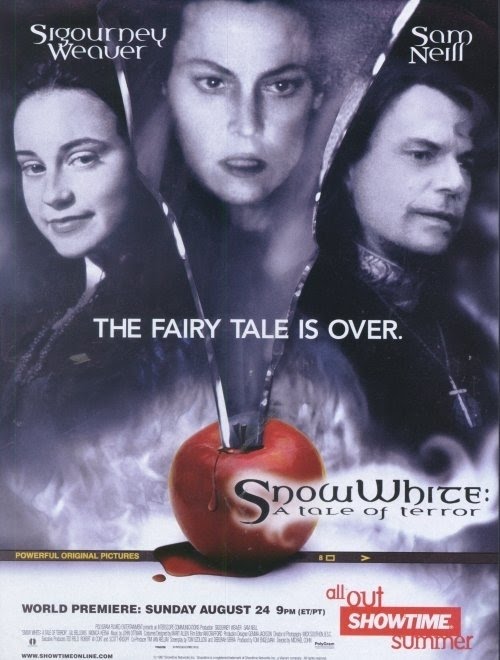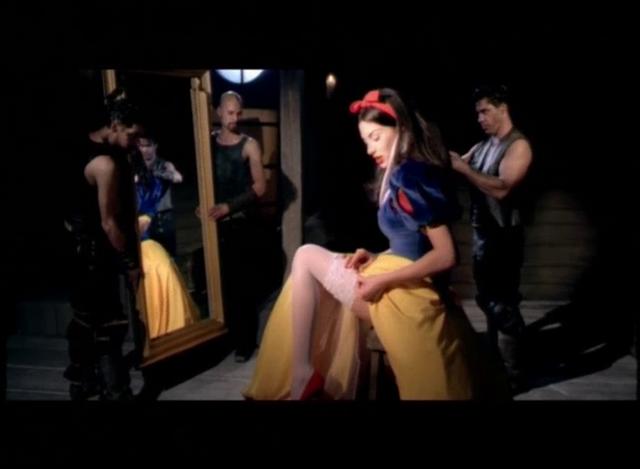Deconstructing Disney: The Original Scary Tales Behind Walt’s Fairy Tales
Everyone knows the stories: beautiful young women, tormented by evil queens and wicked stepmothers, only to be rescued and drawn into a life of luxury by their one true love, conveniently a handsome prince. When Walt Disney began plucking plots from the tales of Grimm, Perrault, and Anderson to use as the basis for his animated features, no one truly realized the extent to which these dark and dreary fairy tales would be permanently altered in the collective psyche. Mention Snow White to just about anyone these days, and their mind will conjure the red-bowed yellow-skirted Disney animated classic princess; the same could be said for Cinderella, Sleeping Beauty, and now even Rapunzel. But what of the original stories, the fodder for these Disneyfied happy-ending animated films? They were just a little bit different than Walt and his successors might have you believe.
CINDERELLA

Full of dancing and singing mice, and talented tailoring birds, Disney’s saccharine sweet Cinderella story manages to gloss out all of the darkest aspects of the original tale, which is considered to be one of the oldest fairy tales on record, with root going back all the way to Ancient Egypt. The most commonly accepted version of the tale, however, comes from Perrault, with a darker version coming from the Brothers Grimm. Ella is a beautiful maiden trapped in the home of her evil stepmother and two cruel stepsisters, beautiful women who are haughty and cold in their hearts; forced into servitude, young Ella would spend her nights curled up on the floor near the hearth in an effort to keep warm, earning her the mocking nickname ‘Cinderella’.
One day, her father is journeying into town and asks Cinderella and her stepsisters what he should bring back for them; the stepsisters ask for fine clothes and jewels, but Cinderella only asks for him to snap off the first twig that brushes his hat along the way. He does as she asks, and Cinderella plants the twig on her mother’s grave, where it soon grows into a beautiful tree. Each time Cinderella went to the tree and prayed, a little bird would appear and throw down to her whatever she wished for. When a festival is thrown by the local prince, Cinderella begged the little bird for beautiful clothes, and for three nights attended the festival decked out in increasingly beautiful dresses made of gold and silver and dances with the prince, until on the third night, in her rush to return home and not be discovered by her stepmother, Cinderella leaves behind a dainty golden slipper – later changed to glass. Obsessed with his dancing partner, the prince declares he will only marry the owner of the slipper, and sets out to try it on every woman in the kingdom.
Here is where it gets nice and gruesome. With Cinderella hidden away, the first stepsister tries on the slipper and, finding it too small for her feet, her mother instructs her to cut off her toes in order to make it fit. The prince had nearly carried her away to his castle when he spies the blood on the shoe and returns her home. The second stepsister tries the shoe and again, finds her foot too big; this time, the mother instructs her to carve off her own heel to make it fit, and she complies. Again, the dolt of a prince notices nothing wrong until he spies the bloody shoe, and returns again, demanding to see the last young woman of the household, Cinderella. When the shoe fits, he carries her off, but the story doesn’t end there. The stepsisters, trying to curry favor with the newly made princess, marched in the wedding procession; on their way to the church, birds swooped down from the sky and pecked out the outer eye of each stepsister, repeating the process on the way back to blind both for their haughtiness and cruelty. Yowch.
Another Option:

This 2006 Korean film by the same name as the classic tale may seem nothing like its namesake, but everything becomes apparent by the end. A tale of plastic surgery gone not quite right, it is definitely worth your time.
SLEEPING BEAUTY

One of the more beautifully animated Disney films, Sleeping Beauty combined the artful animation of their talented studios with songs written to the tune of Tchaikovsky’s ballet. Produced in 1959, the film was made long before parents would find themselves pulling their children from the screens in horror at the appearance of an evil dark faerie and a giant black dragon with glowing eyes. Though the film contains the token happy ending that has come to typify Disney films, it is a hard won battle fought against a fantastic score; the film even features a fun drunken sing-along by two kings, one short and round and the other tall and thin. It is worth a viewing by even adults who have not yet seen it, if only to gaze in wonder at the art of the animation. That being said… it did of course deviate quite strongly from the original tale, particularly at the end.
The Disney tale follows much the same storyline as the original, until the princess falls into her slumber. In the Disney film, a matter of days, or perhaps weeks, pass before her prince is able to fight his way into the castle to rescue her. Instead, in the original tale, a full century goes by before a passing prince happens upon the legend of the beautiful princess asleep in the castle buried in thorns and brambles, and fights his way inside to find her. Rather than a kiss waking the princess, the poisoned needle still stuck in her fingertip is suckled out… by the twins she bears following the prince’s visit, searching for sustenance from their sleeping mother. It’s clear enough why this little tidbit didn’t make the Disney animated classic.
The story doesn’t end there. The awakened beauty goes on to join her children’s father, only to be confronted with a jealous ogress of a Queen Mother, intent on devouring her newly birthed grandchildren. Eventually, the evil queen finds her way into a pit of vipers, and Sleeping Beauty finds her happy ending – nine months after her prince found his!
Another Option:
Normally I would say to watch this horror entry instead of the Disney classic but, again, the artistic turn the animation took in this film is definitely worth a peek, so watch this horror entry as well as the Disney classic.

Noted as a darkly erotic retelling of the classic tale, this 2011 film entry is a sexually charged dark drama about young women working in service of older men.
SNOW WHITE

Everything Snow White is suddenly all the rage, an interesting occurrence, given that Disney has been shuffling their first princess to the background in favor of their newer animated stars. Two new live action versions of the tale have already hit theaters, one of which stars everyone’s favorite expressionless actress, Kristen Stewart. The character of Snow White also features heavily on the ABC fantasy-drama Once Upon a Time, and was an important character in the 1990’s miniseries The 10th Kingdom. But in spite of this resurgence in popularity outside of the animated realm, Disney’s version of the tale still ranks highest among fans and pop culture references. The Disney tale does well to follow the original story – to a point – but makes a fair number of changes along the way. The nameless dwarves of the original tale are given the names that stick with them even now, and a good portion of the tale is cut away.
“Once upon a time in the middle of winter, when the flakes of snow were falling like feathers from the sky, a queen sat at a window sewing, and the frame of the window was made of black ebony. And whilst she was sewing and looking out of the window at the snow, she pricked her finger with the needle, and three drops of blood fell upon the snow. And the red looked pretty upon the white snow, and she thought to herself, would that I had a child as white as snow, as red as blood, and as black as the wood of the window-frame.”
The queen gets her wish – but doesn’t live to see the child grow. Feeling his daughter needed a mother, the child’s father marries a beautiful but haughty and cold woman, who dabbles in dark magic and carries with her a magic mirror. Every day, she poses the same question to the mirror: Who is fairest in all the land? All goes well, as long as the mirror reassures the Queen that she indeed is fairest. The day Snow White turns seven, however, the answer changes: young Snow White is fairest of them all. This enrages the Queen, who calls her faithful huntsman to take the girl into the woods, kill her, and cut out her heart, lungs and liver. The huntsman attempts to follow through, but seeing the terror on the beautiful child’s face, he lets her go, and kills a wild pig instead, delivering the requested organs to the queen, who boils them with salt and eats them.
Alone in the woods, the young Snow White happens upon the cottage of seven dwarves, who agree to take her in so long as she does all the cooking, cleaning, and mending for them, while they spend their days away in the mines. She agrees, and they warn her that the Queen must still be after her, and not to let any strangers speak to her. It turns out the dwarves are right, as the Queen’s magic mirror indeed tells her that young Snow White still lives. She immediately sets out to kill the girl herself, making three attempts on the young girl’s life. First, she gives her a corset and pulls the stays so tight that it cuts off the girl’s breath and she faints, only to be later revived by the dwarves. Second, she comes with a decorative comb laced with poison, and again Snow White falls for the trick and falls dead away to the floor, once again to be revived by the dwarves when they remove the comb from her hair. The third and final time, the Queen comes with a poisoned apple and with one bite, Snow White dies; the dwarves are unable to revive her again.
Unable to part with the dear little Snow White, the dwarves build her a coffin of crystal and gold and place it in the woods. One day, a passing prince spies the dead girl and becomes so enamored that he must take her with him. Harnessing the coffin to his horse, he tries to take her away; the motion from the harness shakes loose the bite of poison apple stuck in her throat, and Snow White revives to marry the prince. However, all is not yet well; the evil Queen and her mirror still search for a greater beauty, and they find it in the young queen of a neighboring kingdom. When the wicked Queen goes to spy upon this new beauty, she is recognized by Snow White and forced into a pair of iron shoes gone red hot from sitting in the hearth, and made to dance and dance until she drops dead. So much for happy endings.
The implications of this tale raise a lot of questions. Child murder and cannibalism is, after all, the Queen’s main goal, harkening to a time when the consumption of another’s flesh was thought to imbue the devourer with their victim’s traits – in this case, beauty. The sending of a child, while only seven years old but still lovely and grown enough to be recognized as beautiful – into the woods with an older man gives off the intent of a sexual predatory nature, much the same as the dwarves taking the girl as their pseudo-bride, to keep their house and home. And finally, beautiful or not, what does a prince want with a corpse? There is no indication of the passage of time while Snow White lives with the dwarves, so she may well have gone off to be a child-bride. It is a sketchy tale, to say the least.
The Disney version ages Snow White to at least a teenager and trims away any suggestion of deviance; even the Evil Queen meets her end not by Snow White’s revenge, but by the wrath perhaps of an angry god, falling to her death from a cliff after a lightning strike.
Another Option:

Sigourney Weaver is one bad-ass wicked queen. A fairly creepy take on the tale, the old crone disguise taken on by Weaver is alone worth giving the film a peek.
Also notable – if you haven’t the attention span for a full film – is the Rammstein video for their song ‘Sonne’, which, as well as being a great track, is an inventive take on the Snow White legend.
Disney has long been in the habit of purifying these dark and dreary tales that the world as raised on, to the degree that the real tales are rarely known anymore. It takes only a little digging to find the darker roots more relevant to the modern horror fan. Perhaps, in time, we’ll see more dark films made that will appeal to those of us who wouldn’t mind a little blood and bad behavior.


READ THIS ……….IT IS VERY DIFFERENT FROM WHAT WE HAVE KNOWN.